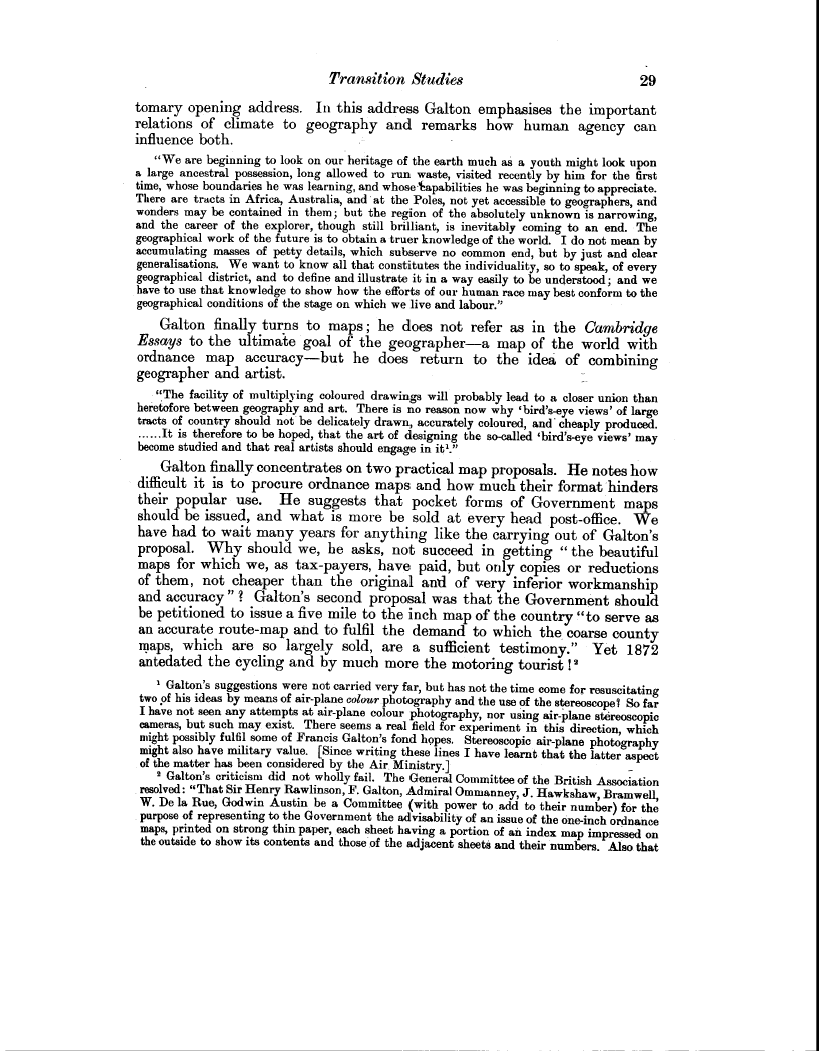Transition Studies 29
tomary opening address. In this address Galton emphasises the important relations of climate to geography and remarks how human agency can influence both.
"We are beginning to look on our heritage of the earth much as a youth might look upon a large ancestral possession, long allowed to run waste, visited recently by him for the first time, whose boundaries he was learning, and whose-tapabilities he was beginning to appreciate. There are tracts in Africa, Australia, and ' at the Poles, not yet accessible to geographers, and wonders may be contained in them; but the region of the absolutely unknown is narrowing, and the career of the explorer, though still brilliant, is inevitably coming to an end. The geographical work of the future is to obtain a truer knowledge of the world. I do not mean by accumulating masses of petty details, which subserve no common end, but by just and clear generalisations. We want to know all that constitutes the individuality, so to speak, of every geographical district, and to define and illustrate it in a way easily to be understood; and we have to use that knowledge to show how the efforts of our human race may best conform to the geographical conditions of the stage on which we live and labour."
Galton finally turns to maps ; he does not refer as in the Cambridge Essays to the ultimate goal of the geographer-a map of the world with ordnance map accuracy-but he does return to the idea of combining geographer and artist.
"The facility of multiplying coloured drawings will probably lead to a closer union than heretofore between geography and art. There is no reason now why `bird's-eye views' of large tracts of country should not be delicately drawn, accurately coloured, and " cheaply produced.
... It is therefore to be hoped, that the art of designing the so-called 'bird's-eye views' may become studied and that real artists should engage in it'."
Galton finally concentrates on two practical map proposals. He notes how difficult it is to procure ordnance maps and how much their format' hinders their popular use. He suggests that pocket forms of Government maps should be issued, and what is more be sold at every head post-office. We have had to wait many years for anything like the. carrying out of Galton's proposal. Why should we, be asks, not succeed in getting " the beautiful maps for which we, as tax-payers, have paid, but only copies or reductions of them, not cheaper than the original anti of very inferior workmanship and accuracy"? Galton's second proposal was that the Government should be petitioned to issue a five mile to the inch map of the country "to serve as an accurate route-map and to fulfil the demand to which the, coarse county maps, which are so largely sold, are a sufficient testimony." Yet 1872 antedated the cycling and by much more the motoring tourist!'
I Galton's suggestions were not carried very far, but has not the time come for resuscitating two of his ideas by means of air-plane colour photography and the use of the stereoscope? So far I have not seen any attempts at air-plane colour photography, nor using air-plane stereoscopic cameras, but such may exist. There seems a real field for experiment in this direction, which might possibly fulfil some of Francis Galton's fond hopes. Stereoscopic air-plane photography might also have military value. [Since writing these lines I have learnt that the latter aspect of the matter has been considered by the Air. Ministry.
2 Galton's criticism did not wholly fail. The General Committee of the British Association resolved: "That Sir Henry Rawlinson, F. Galton, Admiral Ommanney, J. Hawkshaw, Bramwell, W. De la Rue, Godwin Austin be a Committee (with power to add to their number) for the purpose of representing to the Government the advisability of an issue of the one-inch ordnance maps, printed on strong thin paper, each sheet having a portion of an index map impressed on the outside to show its contents and those of the adjacent sheets and their numbers. Also that

